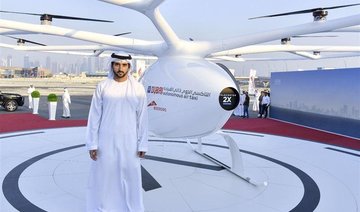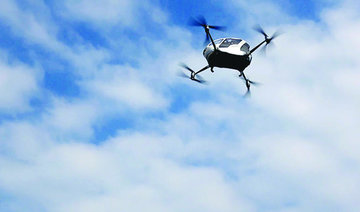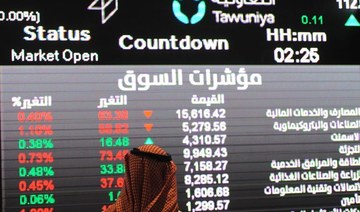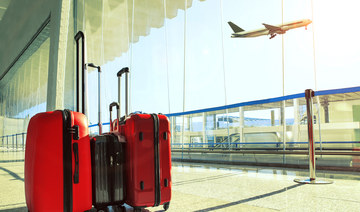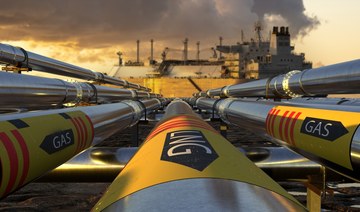FARNBOROUGH, United Kingdom: British engine maker Rolls-Royce revealed plans this week to develop a hybrid electric vehicle, dubbed the “flying taxi,” which takes off and lands vertically and could be airborne within five years.
The London-listed aerospace giant, which is based in Derby in central England, showed off the plans at the Farnborough Airshow for the first time, as other players also rush into the market segment.
Rolls said it hoped to manufacture a prototype version of its electric vertical take-off and landing (EVTOL) vehicle within the next 18 months, and could potentially take to the skies in the early 2020s.
The Rolls-Royce EVTOL plane will seat four or five people, with a flying range of 500 miles (805 kilometers) and a top speed of 200 miles per hour.
“In this market, you will see something like this flying within three to five years, and we will demonstrate the system in two years,” said Rob Watson, head of Rolls-Royce’s electrical team.
“At the end of next year we will be flight ready,” he said at the group’s Farnborough chalet.
The hybrid vehicle, which has so far cost single-digit millions of pounds to develop, will use a traditional gas turbine engine with an electrical system wrapped around it.
Rolls-Royce is also researching an all-electric product but that is not as advanced as the EVTOL offering.
“There is an emerging market for all-electric planes but we believe that you need a level of requirement that an all-electric system cannot really provide today,” Watson said.
“So, all-electric is the way to hop around within a city, but if you want to travel 200 or 300 miles, if you want to run London to Paris, then you are going to want to run something that will give you that range.
“So we think you will see hybrid propulsion systems starting to make this market.”
Rolls is not alone in the hybrid “flying taxi” marketplace.
Other companies researching the sector include US taxi-hailing company Uber, the Google-backed Kitty Hawk project, Lilium Aviation in Germany, Safran in France, and Honeywell in the United States.
The aerospace sector’s push into electric propulsion has drawn comparisons with the automotive industry, where electric cars are gaining ground in terms of popularity and performance.
“Think of it like the car industry. Historically everybody had an internal combustion engine. over time you add more electric capability to it and then you start to see electric cars,” added Watson.
“In the same way, we are introducing a hybrid propulsion system into this market because we think it gives you that range and capability.”
David Stewart, aviation and aerospace adviser and partner at Oliver Wyman, said that the aerospace sector was facing pressure to become more environmentally friendly.
“I think that electrical propulsion is a potential disruptor to the way things are powered,” said Stewart, who will speak at Farnborough on Tuesday.
“We are quite a long way for electrical power to be a replacement for kerosene, but never say never.”
He cautioned that Rolls-Royce’s flying taxi concept was in reality a development platform to test the new technology.
The real market opportunity will likely be a scaled-up version of 10-15 seats that can serve a wider variety of applications, according to Stewart.
Watson added: “Over time you’ve got more electrical capability for bigger and bigger aircraft — and that’s really what we are thinking about today.
“We are learning today about the technology that we will need tomorrow.”
Rolls-Royce unveils hybrid flying taxi at Farnborough
Rolls-Royce unveils hybrid flying taxi at Farnborough
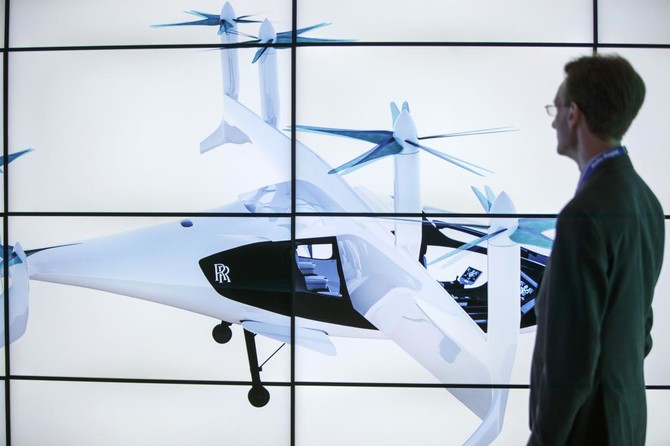
- Rolls-Royce hopes to manufacture a prototype version of its electric vertical take-off and landing vehicle within the next 18 months
- Rolls-Royce is also researching an all-electric product but that is not as advanced as the EVTOL offering
Chinese models to drive Mideast EV sales amid global surge: IEA
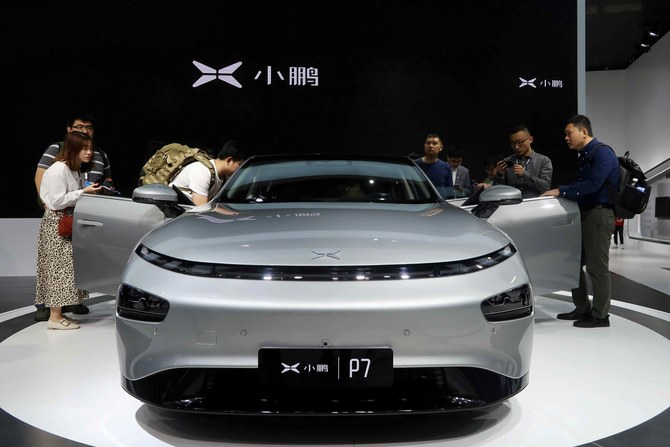
- The IEA report disclosed that global sales of electric cars grew by approximately 25 percent in the first quarter of this year compared to the same quarter in 2023
RIYADH: The entry of Chinese car models in the Middle East could drive regional electric vehicle sales, as global figures are projected to reach 17 million units by 2024.
According to the latest International Energy Agency report, this marks a 21.42 percent increase from the previous year, with nearly 60 percent of new electric car registrations in 2023 occurring in China, followed by 10 percent in the US and 25 percent in Europe.
“The continued momentum behind electric cars is clear in our data, although it is stronger in some markets than others. Rather than tapering off, the global EV revolution appears to be gearing up for a new phase of growth,” said Fatih Birol, executive director of the IEA.
The Global EV Outlook 2024 stated that the electric car market in Africa, Eurasia, and the Middle East is still in its nascent stage, with such vehicles representing just under 1 percent of total sales in these regions.
However, the decision of Chinese carmakers to explore these regions, along with producing vehicles domestically, could change this trend, allowing the market to expand in the coming years.
“In Uzbekistan, BYD (Chinese automaker) set up a joint venture with UzAuto Motors in 2023 to produce 50,000 electric cars annually, and Chery International established a partnership with ADM Jizzakh,” stated the IEA in the report.
This partnership has already led to a steep increase in electric car sales in Uzbekistan, reaching around 10,000 in 2023.
It added: “In the Middle East, Jordan boasts the highest electric car sales share, at more than 45 percent, supported by much lower import duties relative to ICE (internal combustion engine) cars, followed by the UAE, with 13 percent.”
Moreover, in July last year, Saudi Arabia’s Ministry of Investment signed a $5.6 billion deal with Chinese electric car maker Human Horizons to collaborate on the development, manufacture, and sale of vehicles.
Steady growth
The IEA report disclosed that global sales of electric cars grew by approximately 25 percent in the first quarter of this year compared to the same quarter in 2023.
Highlighting the growth of the EV market, the report revealed that the number of electric cars sold globally in the first three months of this year is roughly equivalent to the total units sold in 2020.
The steady growth in the first quarter of this year was driven by China, with 1.9 million EVs sold, marking a 35 percent rise compared to the same period in 2023.
In Europe, the first quarter of 2024 witnessed year-on-year growth of over 5 percent, slightly surpassing the growth in overall car sales and thus maintaining the EV sales share at a similar level to that of last year.
The US also experienced a 15 percent increase in sales in this segment during the first three months of this year, compared to the same period in 2023.
According to Birol, the rise in investments in the electric battery sector is a strong indication of the rise of the EV appetite globally.
“The wave of investment in battery manufacturing suggests the EV supply chain is advancing to meet automakers’ ambitious plans for expansion. As a result, the share of EVs on the roads is expected to continue to climb rapidly,” said the executive director of IEA.
He added: “Based on today’s policy settings alone, almost one in three cars on the roads in China by 2030 is set to be electric, and almost one in five in both the US and the EU. This shift will have major ramifications for both the auto industry and the energy sector.”
EV prices to fall
The report highlighted that the pace of the transition to EVs may not be consistent and will hinge on affordability.
IEA added that manufacturers have taken significant steps to deliver on the strengthening EV ambitions of governments by making significant financial commitments.
“Thanks to high levels of investment over the past five years, the world’s capacity to produce batteries for EVs is well positioned to keep up with demand, even as it rises sharply over the next decade,” said the report.
According to the intergovernmental organization, more than 60 percent of electric cars sold in 2023 were already less expensive to buy than their conventional equivalents in China.
However, the purchase prices for cars with internal combustion engines remained cheaper on average compared to EVs in the US and the EU.
The report suggested that intensifying market competition and improving battery technologies are expected to reduce the prices of electric cars in the coming years.
“Even where upfront prices are high, the lower operating costs of EVs mean the initial investment pays back over time,” said IEA.
Moreover, growing electric car exports from Chinese automakers, which accounted for more than half of all electric car sales in 2023, could add to downward pressure on purchase prices.
IEA also underscored the vitality of ensuring the availability of public charging slots to maintain the steady growth of the electric car market globally.
According to the report, the number of public charging points installed globally was up 40 percent in 2023 compared to 2022, and growth for fast chargers outpaced that of slower ones.
However, IEA added that charging networks globally need to grow sixfold by 2035 to meet the level of electric vehicle deployment in line with the pledges made by governments.
“At the same time, policy support and careful planning are essential to make sure greater demand for electricity from charging does not overstretch electricity grids,” concluded the report.
Closing Bell: Tasi slips for the second consecutive day
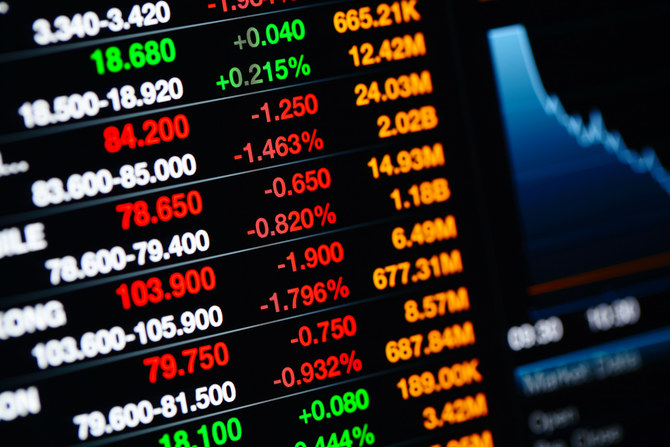
RIYADH: Saudi Arabia’s Tadawul All Share Index continued its downward trend for the second consecutive day as it shed 24.52 points to close at 12,484.41.
The total trading turnover of the benchmark index was SR8.44 billion ($2.25 billion), with 71 of the listed stocks advancing and 157 declining.
On the other hand, Saudi Arabia’s parallel market Nomu gained 95.74 points on Tuesday to close at 26,691.96.
However, the MSCI Tadawul Index slipped by 0.24 percent to 1,563.40.
The best-performing stock of the day was United Cooperative Assurance Co. The firm’s share price rose by 6.67 percent to SR13.44.
Other top performers include Etihad Atheeb Telecommunication Co. and Gulf Union Alahlia Cooperative Insurance Co., whose share prices surged by 4.84 percent and 4.54 percent, respectively.
The worst performer in the main market was Fitaihi Holding Group, as its share price slipped by 4.77 percent to SR4.19.
The parallel market’s positive performance was driven by Osool and Bakheet Investment Co., whose share price soared by 7.83 percent to SR36.50.
On the announcements front, Middle East Paper Co. said it has started its cardboard factory project, which will have a production capacity of 450,000 tonnes.
In a statement to Tadawul, MEPCO revealed that the feasibility study for the project has been completed with a final budget of SR1.78 billion.
The company went on to say that the undertaking would be completed in 42 months.
The initiative will be funded by the MEPCO’s internal resources, by long-term loans from local banks and the use of funds resulting from the issuance of the shares to Saudi Arabia’s Public Investment Fund, the statement added.
Meanwhile, in another statement, MEPCO revealed that it signed another agreement with J.M. Voith SE & Co. KG, for manufacturing, supplying and supervising the installation of the main machine for the cardboard project.
Egypt increases funding needed in 2024-2025 budget by over $59bn
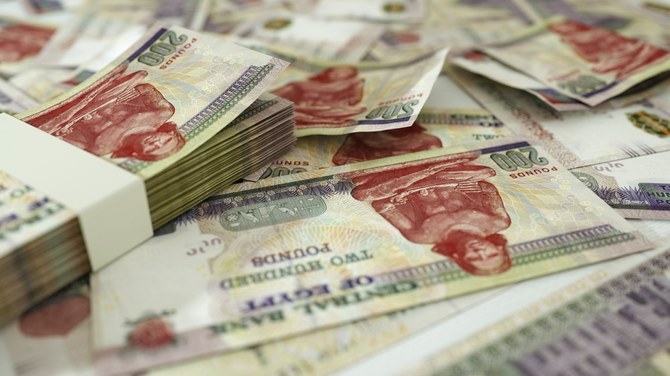
RIYADH: Egypt has increased the amount of funding required in its 2024-2025 budget by over 2.8 trillion pounds ($59 billion) following successive shock waves.
In the financial statement of the new draft budget, Minister of Finance Mohamed Maait highlighted that the changes are reflective of the continuous struggles that the North African country has been facing following the COVID-19 epidemic.
The added funding aims to alleviate the inflationary effects that have been burdening the Egyptian public, improve the standard of living, and meet the developmental needs of citizens, the report said.
The allocation of spending in the budget will also seemingly reflect the needs of individuals by increasing spending on health and education and aiming to improve job opportunities.
Egypt’s economy has witnessed blows over the last half year due to the ongoing crisis in Gaza, which has slowed tourism growth and cut into Suez Canal revenue, two of the country’s biggest sources of foreign currency.
Amid a staggering shortage of foreign currency and rapidly increasing inflation, the challenges prompted the International Monetary Fund to expand its financial support to Egypt to $8 billion in an attempt to shore up the country’s economy.
In a statement in March, the IMF board said its decision would enable Egypt to immediately receive about $820 million.
Similarly, the UAE, represented by a private consortium led by the Abu Dhabi Developmental Holding Co., signed a landmark agreement with Egypt in February to invest $35 billion in Ras El-Hekma, a region on the Mediterranean coast 350 km northwest of Cairo.
Since securing the deal, which marked the single largest foreign direct investment in the North African country, the nation launched some long-sought reforms with the central bank delivering a 600 basis-point interest rate hike and a pledge to unshackle its currency alongside a devaluation.
This led S&P Global Ratings to note that it has been encouraged by the rush of financial support to Egypt, therefore lifting its economic outlook for the country to positive from stable after the long-awaited currency devaluation, which is poised to ease foreign currency shortages.
Saudi Arabia’s aviation growth plays pivotal role in economic development: GACA president
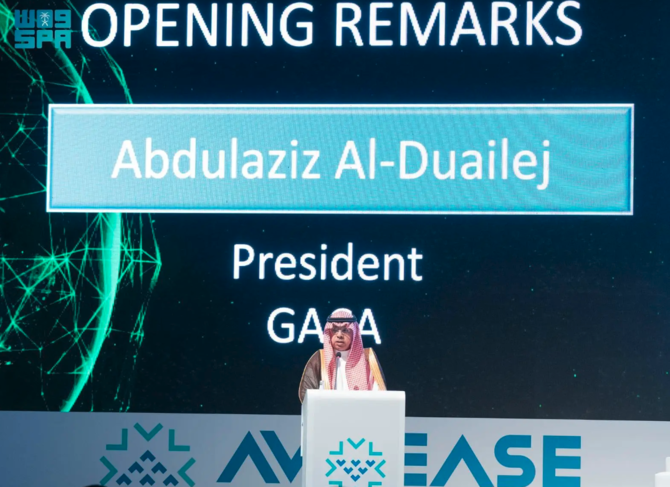
RIYADH: Growth in air traffic, heightened investment interest, and a comprehensive strategy are driving Saudi Arabia’s aviation sector expansion, according to a top official.
Abdulaziz Al-Duailej, president of the Saudi General Authority of Civil Aviation, highlighted the sector’s pivotal role in economic growth and sustainable development during his speech at the Airlines Economic Growth Frontiers conference in Riyadh.
Al-Duailej emphasized that Saudi Arabia is significantly advancing its civil aviation sector under Vision 2030 and the National Aviation Strategy, according to a report by the Saudi Press Agency.
The initiative aims to cement the Kingdom’s leadership in Middle Eastern civil aviation by enabling investments worth $100 billion by 2030 and leveraging private sector resources and expertise.
The strategy also outlines a holistic plan to upgrade airport services, airlines, and associated facilities, including cargo and logistics.
It aims to enhance the Kingdom’s global air connectivity through 29 airports, significantly grow passenger numbers, and establish Saudi Arabia as a premier center for cargo and logistics by 2030.
Al-Duailej pointed out the initiative’s focus on enabling competition and efficiency to stimulate investment and growth, overseeing its implementation, and ensuring compliance with regulations that provide safety, security, and sustainability.
He also highlighted the significant progress made in the aviation sector’s infrastructure and overall performance, driven by several undertakings launched by GACA.
These initiatives include massive investments that offer unprecedented opportunities for global aviation investors and operators.
He also mentioned a partnership between the public and private sectors to triple Abha International Airport’s capacity to accommodate 10 million passengers by 2030. The airport has already received interest from 100 companies to participate in this project.
Among the undertakings is the establishment of Riyadh Air, the launch of the master plan for King Salman International Airport in Riyadh, which aims to serve nearly 120 million passengers by 2030, and the opening of the Red Sea International Airport.
Moreover, Al-Duailej highlighted the launch of the National Air Connectivity Program to support the tourism and travel sectors in the Kingdom.
He also discussed significant investments in renewable energy and advanced air transport involving Saudia Airlines and NEOM, alongside substantial expansions by The Helicopter Co.
These efforts align with broader regulations promoting environmental awareness, ensuring balanced and sustainable growth for the aviation sector in the Kingdom in the long term.
Regarding passenger traffic, Al-Duailej revealed that the Kingdom saw a 26 percent increase last year, reaching a record 112 million travelers and surpassing 2019 figures by 8 percent.
In the first two months of this year alone, air traffic increased by 20 percent compared to the same period in 2023.
Another point of emphasis was the increase in air connectivity to nearly 150 destinations, with low-cost airlines driving growth between 2019 and 2023, thereby doubling their market share both domestically and internationally.
The Airlines Economic Growth Frontiers conference, hosted by AVILEASE, a subsidiary of the Public Investment Fund, aims to highlight opportunities within the civil aviation sector.
The event, held at the Four Seasons in Riyadh from April 22-23, saw the presence of the vice presidents of the GACA, representatives of the PIF, and numerous officials and industry stakeholders from around the world.
TotalEnergies, OQ to launch $1.6bn LNG Bunkering project in Oman
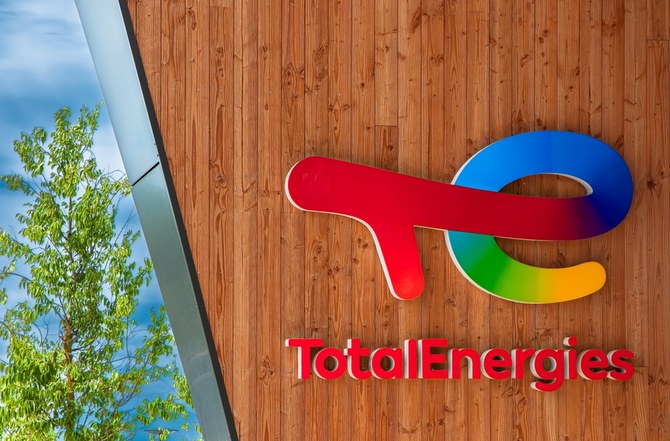
RIYADH: Oman’s Sohar Port is set to house a new $1.6 billion liquefied natural gas bunkering plant following an agreement inked between OQ and TotalEnergies.
Bunkering involves transferring LNG to a ship for use as fuel, offering a cleaner alternative compared to traditional methods such as marine gas oil and heavy fuel oil.
TotalEnergies will provide 80 percent of the investment, with OQ contributing the remaining 20 percent through their joint venture, Marsa Liquefied Natural Gas LLC.
The Marsa LNG project, the first of its kind in the Middle East, is poised to have significant economic implications. It’s expected to bolster Oman’s treasury revenues and enhance local value through collaborative local investments.
Patrick Pouyanne, chairman and CEO of TotalEnergies, said: “We are proud to open a new chapter in our history in the Sultanate of Oman with the launch of the Marsa LNG project, together with our partner OQ, demonstrating our long-term commitment to the country.”
He explained that the innovative project illustrates their pioneer spirit and showcases the relevance of their integrated multi-energy strategy, with the ambition of being a responsible player in the energy transition.
“By paving the way for the next generation of very low emission LNG plants, Marsa LNG is contributing to making gas a long-term transition energy,” Pouyanne added.
The plant, powered entirely by solar energy, is expected to contribute to the reduction of carbon emissions and the shipping industry’s overall carbon footprint. Notably, it is projected to emit less than 3 kg of carbon dioxide per oil equivalent barrel.
“The Marsa LNG project is one of the many initiatives that reflect Oman’s goal of achieving carbon neutrality by 2050,” Minister of Energy and Minerals Salim Al-Aufi said.
Furthermore, the new bunkering plant reflects OQ’s commitment to strategically contributing to the development of the country’s energy sector for creating long-term sustainable value.
OQ Chairman Mulham Basheer Al-Jarf noted: “The project will contribute to OQ Trading’s position as a key player in the LNG markets.”
“OQ Gas Network will also provide the necessary gas transportation services to the project,” Al-Jarf added.
The project is expected to provide additional direct financial revenues to Oman, increase traffic to the city’s ports, and enhance local investments.
It is also set to expand the gas and alternative energy supply network and create new job opportunities in the country.


